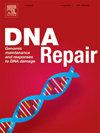The role of human PrimPol active site residue Gln48 in catalysis and complex formation with DNA
IF 2.7
3区 生物学
Q2 GENETICS & HEREDITY
引用次数: 0
Abstract
Human PrimPol is a primase-polymerase involved in the mechanism of DNA synthesis reinitiation at the sites of DNA damage and replication fork collapse. By using its DNA primase activity, PrimPol synthesizes DNA primers which can be utilized by high-fidelity DNA polymerases to resume replication downstream of the damaged site. Disruption of PrimPol function may be associated with an increased risk of cancer and ophthalmologic diseases. Understanding the detailed mechanism of catalysis and regulation of PrimPol activity is crucial for predicting how mutations and polymorphisms affect enzyme function within the cell. In this study, we conducted a biochemical investigation of the role of the conserved Gln48 residue in the PrimPol active site in DNA synthesis by replacing glutamine with a positively charged arginine (Q48R) or a negatively charged glutamic acid (Q48E). The PrimPol variant with the Q48R substitution is also represented in the NCBI dbSNP (rs939272279 A/G). Both substitutions resulted in impaired complex formation of PrimPol with DNA and significantly reduced the catalytic activity of the enzyme, indicating the important role of the Gln48 residue in forming contacts with the template DNA and active site organization. The data obtained suggest that the Q48R substitution may disrupt PrimPol functions.
人PrimPol活性位点残基Gln48在催化和与DNA形成复合物中的作用
人PrimPol是一种引物聚合酶,参与DNA损伤和复制叉崩溃位点的DNA合成再起始机制。PrimPol利用其DNA引物酶活性合成DNA引物,这些引物可以被高保真DNA聚合酶利用来恢复受损位点下游的复制。PrimPol功能的破坏可能与癌症和眼科疾病的风险增加有关。了解PrimPol活性的详细催化和调控机制对于预测突变和多态性如何影响细胞内酶的功能至关重要。在这项研究中,我们通过用带正电的精氨酸(Q48R)或带负电的谷氨酸(Q48E)取代谷氨酰胺,对PrimPol活性位点上保守的Gln48残基在DNA合成中的作用进行了生化研究。具有Q48R替换的PrimPol变体也在NCBI dbSNP (rs939272279 A/G)中表示。这两种取代都导致PrimPol与DNA的复合物形成受损,并显著降低了酶的催化活性,这表明Gln48残基在与模板DNA形成接触和活性位点组织方面发挥了重要作用。得到的数据表明,Q48R的取代可能会破坏PrimPol的功能。
本文章由计算机程序翻译,如有差异,请以英文原文为准。
求助全文
约1分钟内获得全文
求助全文
来源期刊

DNA Repair
生物-毒理学
CiteScore
7.60
自引率
5.30%
发文量
91
审稿时长
59 days
期刊介绍:
DNA Repair provides a forum for the comprehensive coverage of DNA repair and cellular responses to DNA damage. The journal publishes original observations on genetic, cellular, biochemical, structural and molecular aspects of DNA repair, mutagenesis, cell cycle regulation, apoptosis and other biological responses in cells exposed to genomic insult, as well as their relationship to human disease.
DNA Repair publishes full-length research articles, brief reports on research, and reviews. The journal welcomes articles describing databases, methods and new technologies supporting research on DNA repair and responses to DNA damage. Letters to the Editor, hot topics and classics in DNA repair, historical reflections, book reviews and meeting reports also will be considered for publication.
 求助内容:
求助内容: 应助结果提醒方式:
应助结果提醒方式:


